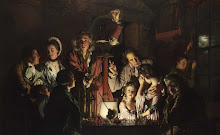A Look into Renaissance Work
Take a look at where Christ's wounds should be. His hands, nailed to the cross, are not clearly visible and conceal his wounds. The entry wound from the stab on his right side is not bleeding. His head, where the crown of thorns was placed, is also free of blood. Was this meant to depict a complete resurrection with all his wounds healed? Or did Fiorentino want his viewers to see his vision of how he perceived this particular event?
The painting is painstakingly detailed, as is typical of works from this period. It also reflects another characteristic of Renaissance art: the incorrect proportions of body parts. In this painting, Christ appears to have the physique of a Greek god. The details in his obliques and the vascularity in his arms are remarkable. I genuinely feel a bit envious looking at this painting. Is that the reaction Fiorentino was aiming for? Notice how much larger Christ is compared to the angels. Could this be a form of symbolism? Were gods depicted as much bigger than the average man or woman? His elongated thighs and disproportionately small feet seem unlikely to support such a large frame. There are many intriguing details to ponder while examining this work.
The humanism in this work is evident in the sheer aesthetic beauty of Christ's body and the detailed folds of the angels' clothing. Additionally, the painting showcases mannerism through the disproportionate sizes of the human anatomy.
To take a closer look at this image click this link.
Zucker, Dr.S. and Harris, Dr.B. (2015) Rosso Fiorentino, the dead christ with Angels, Smarthistory. Available at: https://smarthistory.org/rosso-fiorentino-the-dead-christ-with-angels/ (Accessed: 17 June 2024).
Renaissance humanism - modern art terms and concepts (no date) Renaissance Humanism. Available at: https://www.theartstory.org/definition/renaissance-humanism/ (Accessed: 17 June 2024).
_-_The_Dead_Christ_with_Angels_-_Google_Art_Project.jpg)


I really enjoyed reading your post. I did not notice the lack of evidence of his crucifixion portrayed in the painting until you pointed it out. It is a highly detailed and humanistic painting; the curly hair on the angels looks soft, and the details of their clothing are incredible. To me, Christ looks tired and hungry more than he does a Greek god; he seems on the verge of emaciation. Florentino moved to Rome in 1523, where he saw Michelangelo’s Sistine ceiling, as well as art by Raphael and Parmigianino, which resulted in a radical change of his style. Dead Christ with Angels exemplified his new style. (Britannica)
ReplyDeleteBritannica, The Editors of Encyclopaedia. "Rosso Fiorentino". Encyclopedia Britannica, 4 Apr. 2024, https://www.britannica.com/biography/Rosso-Fiorentino. Accessed 19 June 2024.
Rosso Fiorentino | High Renaissance Painter, Mannerist Artist | Britannica
Hey Art, Your point about the size and proportions of Christ's depiction in this piece is a great one. Also, the absence of his wounds brings up a different scene entirely in my head. This depiction of Christ may not be on this earth. To me, it could be interpreted as Christ healing in heaven, even surrounded by angels. The audio included in the article link was also insightful, as it detailed Christ's depiction as well.
ReplyDelete
ReplyDeleteHello Art, I went to quite a few Catholic Churches growing up and I remember all the different art displayed in them, from the paintings on their ceilings, to the amazing stained-glass art like you mentioned. This is an interesting piece, with no blood present and the appearance of him being clean, it does raise some questions. I wonder if he was cleaned before being placed in the tomb. I agree the Humanism in this painting is evident. Thank you for sharing this painting, it is amazing and leaves you wondering.